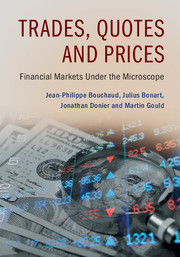Book contents
- Frontmatter
- Dedication
- Contents
- Preface
- Acknowledgements
- PART I HOW AND WHY DO PRICES MOVE?
- PART II LIMIT ORDER BOOKS: INTRODUCTION
- PART III LIMIT ORDER BOOKS: MODELS
- PART IV CLUSTERING AND CORRELATIONS
- PART V PRICE IMPACT
- 11 The Impact of Market Orders
- 12 The Impact of Metaorders
- PART VI MARKET DYNAMICS AT THE MICRO-SCALE
- PART VII ADVERSE SELECTION AND LIQUIDITY PROVISION
- PART VIII MARKET DYNAMICS AT THE MESO-SCALE
- PART IX PRACTICAL CONSEQUENCES
- Appendix
- Index
- References
11 - The Impact of Market Orders
from PART V - PRICE IMPACT
Published online by Cambridge University Press: 26 February 2018
- Frontmatter
- Dedication
- Contents
- Preface
- Acknowledgements
- PART I HOW AND WHY DO PRICES MOVE?
- PART II LIMIT ORDER BOOKS: INTRODUCTION
- PART III LIMIT ORDER BOOKS: MODELS
- PART IV CLUSTERING AND CORRELATIONS
- PART V PRICE IMPACT
- 11 The Impact of Market Orders
- 12 The Impact of Metaorders
- PART VI MARKET DYNAMICS AT THE MICRO-SCALE
- PART VII ADVERSE SELECTION AND LIQUIDITY PROVISION
- PART VIII MARKET DYNAMICS AT THE MESO-SCALE
- PART IX PRACTICAL CONSEQUENCES
- Appendix
- Index
- References
Summary
To measure is to know.
(Lord Kelvin)In this chapter, we address the seemingly obvious notion of price impact (which we first discussed in Section 1.3.2): buy trades tend to push the price up and sell trades tend to push the price down. Expressed in the notation and language that we have subsequently developed, we might also express this notion by saying that price impact refers to the positive correlation between the sign (+1 for a buy order and –1 for a sell order) of an incoming market order and the subsequent price change that occurs upon or after its arrival. As we discuss in Section 11.3, these seemingly obvious statements are indeed verified by empirical data.
Price impact is an all-too-familiar reality for traders who need to buy or sell large quantities of an asset. To these traders, price impact is tantamount to a cost, because the impact of their earlier trades makes the price of their subsequent trades worse on average. Therefore, monitoring and controlling impact costs is one of the most active and rapidly expanding domains of research in both academic circles and trading firms.
Understanding and assessing price impact entails considering two different but related topics. The first is how volume creates impact: how much more impact does a larger trade cause? The second is the temporal behaviour of impact: how much of a trade's impact is permanent, how much decays over time, and how does this transient behaviour unfold? We will consider both of these topics in detail throughout this chapter. As we will discuss, both of these aspects of price impact are far from trivial. Is a transaction not a fair deal between a buyer and a seller? If so, which of the two is really impacting the price?
What Is Price Impact?
In much of the existing literature, there are two strands of interpretation for price impact, which reflect the great divide between efficient-market enthusiasts (who believe that the price is always close to its fundamental value) and sceptics (who believe that the dynamics of financial markets is primarily governed by order flow).
- Type
- Chapter
- Information
- Trades, Quotes and PricesFinancial Markets Under the Microscope, pp. 208 - 228Publisher: Cambridge University PressPrint publication year: 2018



